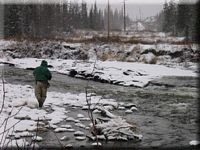
26 Jan Kenai Peninsula Steelhead Fishing
Fire and Ice
On our last steelhead trip to the Anchor River we nearly froze to death… and we loved it!
Anchor Point, Alaska
 Steelhead fishing is always tough. A common saying holds, “if you’re not freezing your a#* off you’re not going to catch a steelhead. For the most part this saying holds true. Winter conditions are normal when pursing the ever allusive anadromous rainbow, and nowhere else can these conditions be quite so extreme but in Alaska. This story involves one very cold but red-hot day on the Kenai Peninsula’s Anchor River.
Steelhead fishing is always tough. A common saying holds, “if you’re not freezing your a#* off you’re not going to catch a steelhead. For the most part this saying holds true. Winter conditions are normal when pursing the ever allusive anadromous rainbow, and nowhere else can these conditions be quite so extreme but in Alaska. This story involves one very cold but red-hot day on the Kenai Peninsula’s Anchor River.
My friend Mike and I kept saying, “Boy, we better get down to the Anchor before it snows.” We both had a very busy fall and thus far had only enjoyed one of a usual half dozen fall steelhead trips. We were both overdue and equally anxious. The fish were there and would continue to be there. The problem is that temperatures were barely above freezing and the next inevitable push of precipitation was sure to be white not wet.
As our 4WD whined up an overgrown trail cut into a bluff overlooking the river, I started to feel different than I had on any other steelhead trip. I really did not want to get out of the truck. I know it was at best 30 degrees outside but with the sustained 30-mph wind the true wind chill was well below zero. I’ve done some pretty stupid stuff just to set a hook but this was a little different, like life threatening.
Once we had our neoprenes on and rods ready we started bailing down the frosty hillside toward the river. Conditions (for the fish) were perfect. The water level was up but not too high and the clarity was good. Normally Mike and I will fish our way up to a couple of larger holes we like, hang out for a while, and fish our way back down. Today there was no stopping. We bee-lined up river to keep warm until we reached our favorite spot. The entire walk up I noticed sheets of ice holding strong along the river’s edge and on shallow bars. Crystal clear, round icicles the size of golf balls were hanging from the trees and riverside foliage, some less than inches from the river’s current. Soon the running water and hanging ice will all become one, solidified under a blanket of snow until spring. I was beginning to think my feet might be frozen that long as well.
As I confirmed with Mike on the ride home, my second thoughts were not alone. Despite our mutual urge to just run right back to the truck, I instinctively unbuttoned my hook and pulled the frozen strains of yarn, that was my fly, away from my rod. I squeezed my fly in my fingers and it felt like a piece of slush. Almost half the eyes on my rod were frozen shut. After frantically picking out the ice, I began fishing the hole. I could make a maximum of two casts before my hands retreated for cover. About my third cast, I felt a small jolt, likely a biter, but I could barely muster a half-hearted hook set. By this time Mike was working the hole behind me and on his second drift he yells out, “there we go” and into the bushes a nice big steelhead went. His 11 foot. noodle rod is bent over good and he’s thumbing him hard to slow the retreat. Unworried, Mike held up his end of the stalemate until the fish finally gave in and was pulled into the icy shallows. A cold and speedy release was over after a quick picture and we both had wet, frozen hands. We had two choices. Start a fire or start a fire. I started collecting wood.
Finally after what felt like big ordeal, we had a good fire going and began to regain feeling in our hands. Now that Mike had caught one, I knew he’d at least triple that. It was either stay by the fire and listen to him the whole ride home or get back in the river. After chipping the ice from my guides, I launched my 2BB slinky with 6-lb. test attached to a very simple but select yarn pattern, into the frosty current. As my graphite rod reverberated the many rocks on the Anchor’s bottom, I felt a bump with gills. It was that tell tale headshake and it was making the end of my rod look like a bungee cord. It was all I could do to get my lethargic muscles to set the hook. Into the trees he went and then right back at me just as fast. As I looked back at Mike he was leaving the fire for the river, shaking his head. The long and short of our day was well over a dozen steelhead hooked and seven landed between Mike and I. We could only bear the frigid wind for two hours. Those two hours were the coldest I’ve ever been period, let alone while fishing. As I settled in to the truck for the ride home I was overcome by a remarkable sense of respect for the cold weather, the fish and the quality of our outing. Shivering over a fire along a freezing Alaskan stream full of steelhead may not be everyone’s idea of fun but I know one angler that would do it again in a heartbeat.
“Weather is the key to…fishing. Foul weather, usually: imitation commando wool sweaters, hooded rain slickers, wool hats, fingerless gloves, long johns, wet cameras, wet camps, cold food, shots of whiskey for the illusion of warmth. It seems to have some weird connection to that good old Protestant ethic wherein anything that’s easy or that feels good is sinful. You can catch trout on a warm, pretty day, of course, but you’ll probably catch more if you suffer. In a strange, masochistic way, it only seems right.” –Taken from “Sex, Death, and Fly Fishing” by John Gierach
The Anchor River is located 115 miles Southwest of Anchorage on the Kenai Peninsula. Beginning in the mountains, the river flows for 34 miles before emptying into Cook Inlet 16 miles north of Homer.The Anchor offers several access points via the Sterling Hwy close to the town of Anchor Point. The Anchor’s Steelhead run has been called the best in Southcentral Alaska and fishing is entirely artificial only and catch and release. Steelhead begin entering the Anchor in late August with the majority of the fish returning from mid-September thought late August. Fishing remains good into November (weather permitting, bring matches) The fish overwinter in the river, spawn in the spring and then return to sea. Recent years have been particularily successful for this wild steelhead stock and fall fishing has been very good.
